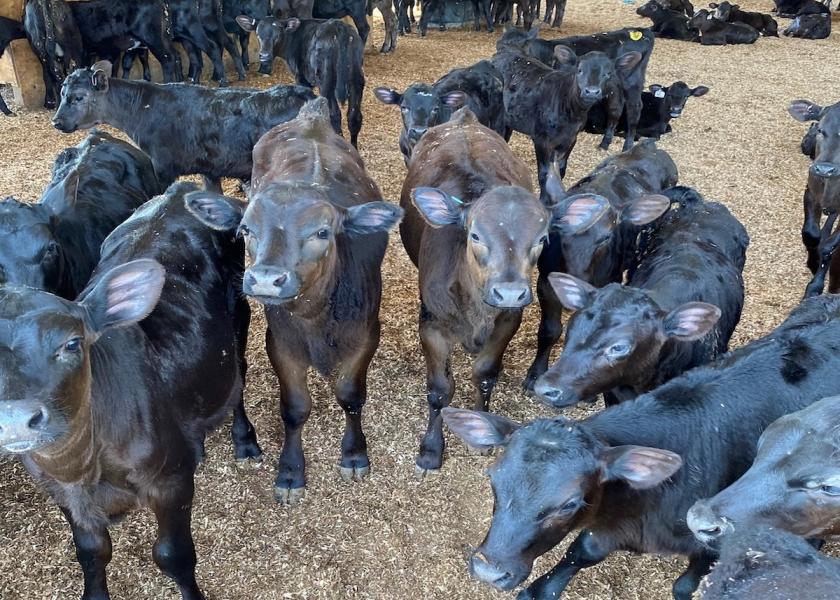Dairy and Beef: A Merger of Many Merits

Beef-on-dairy breeding is a phenomenon that has boomed at a breathtaking pace in the United States, according to Dr. Zeb Gray, Technical Feedlot Specialist for Diamond V.
Gray, who has deep roots in beef production, from the cow-calf phase through post-harvest meat science, said the practice is changing the landscape of the U.S. beef industry – probably permanently.
Data from the National Association of Animal Breeders indicates beef genetics are being swapped for dairy semen at an impressive clip. From 2018-2022, beef semen sales in the United States rose by about 5 million doses, while sales of dairy semen dropped by nearly an identical number.
All the while, the size of the U.S. dairy cow herd remained steady at about 9 million head – an indication that the shift is due largely to the growing adoption of beef-on-dairy breeding.
Gray said that although there have been growing pains, the beef cross calves have been well received by both feedlots and packers. “Feedlots are like hotels,” he explained. “The only way they work financially is if their pens are full. The same is true for packers, whose profitability depends on their maximization of throughput every day.”
He noted the steady, year-round availability of beef cross calves is a game-changer in terms of animal procurement. “It’s always been a challenge for feedyards to keep full pens of consistent cattle year-around, and particularly now with our shrinking native beef herd,” stated Gray. “Calves born on dairies not only offer that consistency, but they are simply age- and source-verified and can provide a complete history of every animal, for which consumers are increasingly clamoring.”
Feedlots, packers, and branded beef programs see working with large dairies as an opportunity to build a reliable source of calves that check all the boxes. It proves to be much easier to work with a handful of large dairies to secure these calves in just a few transactions, versus dealing with a couple hundred ranches and having to buy in much smaller lots.
But for all of its merits, this rapidly evolving production path is not without some speed bumps. The new demand to procure beef cross calves has led to a common occurrence where freshly weaned, very young cattle weighing as little as 250 pounds enter commercial feedyards.
“When it comes to rumen development, there’s no replacement for time,” Gray stated. “Those calves are at a considerable disadvantage compared to their full-blood beef counterparts who are on a partial milk diet for up to 6 months and learn to eat forage gradually alongside their mothers.” He added feedstuff availability in cattle-feeding country and feedyard logistics are often not conducive to including optimal levels of roughage in young calves’ diets.
So, what can dairies and calf ranches do to boost the health and performance of beef cross calves before they graduate to the feedlot? Gray offered 3 suggestions:
- Prioritize critical colostrum – Even if beef cross calves spend less than a day at their dairy of origin, nothing can replace the myriad benefits of colostrum that will carry through their entire productive lives. Setting every calf up for success with colostrum delivery within the first 4 hours of birth is the single most important measure in ensuring calf welfare and preventing morbidity and mortality.
- Focus on nutrition -- There is a growing body of research-based evidence that feeding feedlot-bound calves higher volumes (example: 6 quarts per day) of higher-protein milk replacer (example: 25-27%) results in better-gaining, more robust calves at weaning and beyond. Work with a nutritionist who can help develop both liquid and solid ration formulations, as well as advise inclusion of proven feed additives to support calf health.
- Consider retained ownership – Owning beef cross calves longer – possibly all the way to market – may help dairies expand profit centers beyond milk production, and reap the benefits of investments like feeding calves more nutrient-dense – but also more costly – preweaning rations. It also could allow for a potential backgrounding phase that might help calves transition more smoothly into the feedyard at higher ages and weights.
Gray said the meteoric growth of beef-on-dairy breeding has led to a lag in research that could eventually drive best practices for raising these unique animals. Namely, he said more work needs to be done to discover solutions to the critical issue of liver abscesses in beef cross cattle, along with better-defined nutritional and management approaches to optimize their health and performance.
“The dairy industry has driven this fundamental change thanks to precise reproductive strategies based on genomics, breeding efficiency, and sexed semen. Without them, we wouldn’t have these new opportunities on the beef side,” Gray declared. “I think there is a lot we can continue to learn from each other.”







